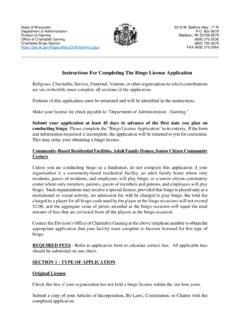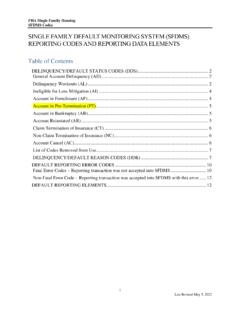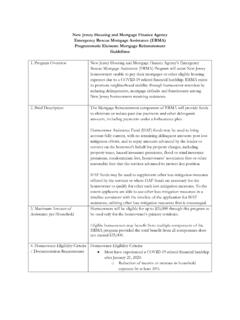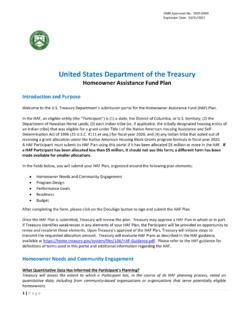Transcription of State of Wisconsin Homeowner Assistance Fund (HAF) …
1 State of Wisconsin Homeowner Assistance fund (HAF). Needs Assessment and Plan WORKING DRAFT IN PREPARATION FOR PUBLIC COMMENT, August 31, 2021. Tony Evers, Governor Joel Brennan, Secretary, Wisconsin Department of Administration 2. Table of Contents Executive Summary ..4. Introduction ..5. Background on DEHCR ..5. Homeownership Landscape in Wisconsin ..5. Map 1: Wisconsin 's Congressional Table 1: Homeowners & Homeownership Rates by District (All Races/Ethnicities & Households of Color) ..6. Table 2: Residential Housing Types in Wisconsin ..6. Figure 1: Share of Homeowners Without a Mortgage ..7. Figure 2: Government-Secured Mortgages by Income, Forbearance Rate and Delinquency Rate ..8. Coronavirus Pandemic Impact.
2 9. Figure 3: Change in Employment, February 2020 - April 2021 ..10. Homeowner Needs Assessment ..12. Assessment Estimating Target Populations ..12. Homeowners who are Low-Income and/or Socially Disadvantaged ..12. Table 3: Households in Owner-Occupied Housing Units by Mortgage Status, Income, & Socially Disadvantaged Status .13. Homeowners with Mortgages ..13. Figure 5: Wisconsin Forbearance & Delinquency Rates, April 2020 - February 2021 ..14. Figure 6: Forbearance Rates by Minority Share of Zip Code April 2020 ..14. Figure 7: Forbearance Rates by Minority Share of Zip Code February 2021 ..15. Figure 8: Forbearance Rates by Low- to Moderate-Income Share of Zip Code April 2020 ..15. Tax Delinquent Property Owners, Including Homeowners without Mortgages.
3 16. Table 4: WCTA Survey Results Tax Delinquent Properties ..16. Homeowners in Manufactured Home Communities (MHCs) ..17. Table 5: MHCs and Median Household Incomes by Congressional District ..17. Program Design ..18. Mortgage Reinstatement/Principal Reduction Program ..18. Non-Mortgage Arrears Satisfaction Program ..22. Budget ..27. Payment Process ..27. Application Process ..27. Methods for Targeting Potential Applicants ..28. Homeowners & Homeownership Rates by District (All Races/Ethnicities & Households of Color) ..28. Legal Services and Housing Counseling ..28. 3. Paid and Earned Media ..28. Grassroots Outreach and Stakeholder Best Practices and Coordination with Other Readiness to Staffing and Systems.
4 29. Contracts and Comment Submission ..31. 4. Executive Summary The Homeowner Assistance fund (the HAF ) was established under section 3206 of the American Rescue Plan Act of 2021 (the Act ) and provides $92,705,301 in financial Assistance to the State of Wisconsin , through the United States Department of the Treasury ( US Treasury ). Governor Tony Evers directed the Department of Administration, Division of Energy, Housing and Community Resources (DEHCR) to manage and operate the HAF on behalf of the State of Wisconsin . The aim of the HAF is to mitigate financial hardships associated with the Coronavirus pandemic by preventing Homeowner mortgage delinquencies, defaults, foreclosures, loss of utilities or home energy services, and displacement.
5 For more information related to the HAF and the US Treasury's guidance to recipients, please visit: This Needs Assessment and Plan (the Plan ) outlines the homeownership landscape in Wisconsin and estimates the impact that the Coronavirus pandemic has had on homeowners. There are an estimated million homeowners in Wisconsin , across multiple market segments. They include mortgaged homeowners who are in forbearance or delinquent on their mortgage; non-mortgaged homeowners who may be delinquent on their property taxes;. condominium owners who may be behind on their monthly maintenance or HOA fees; and manufactured homeowners who may have other types of housing debt, such as chattel loans or retail installment contracts, which also may be in arrears due to the impacts of the Coronavirus pandemic.
6 The Plan proposes relief programs aimed at avoiding foreclosure and/or displacement of low- and moderate-income and Socially Disadvantaged Individuals1. Proposed relief includes two core programs - the Mortgage Reinstatement and Principal Reduction Program and the Non-Mortgage Arrears Satisfaction Program. 1 Socially Disadvantaged Individuals is defined, per US Treasury guidance, as those who have been subjected to racial or ethnic prejudice or cultural bias because of their identity as a member of a group without regard to their individual qualities. The social disadvantage must stem from circumstances beyond their control. There is a rebuttable presumption that the following individuals are socially disadvantaged: Black Americans, Hispanic Americans, Native Americans, Asian Americans and Pacific Islanders.
7 In addition, an individual may be determined to be [Socially Disadvantaged] in accordance with the procedures set forth at 13 CFR. (c) or (d).. 5. Introduction Background on DEHCR. The Department of Administration, Division of Energy, Housing and Community Resources (DEHCR) develops housing policy and offers a broad range of program Assistance and funds to address homelessness and support affordable housing, public infrastructure, and economic development opportunities. The Division partners with local governments and service providers, non-profit agencies, housing authorities, and developers. In addition, DEHCR administers the statewide program to assist eligible households by providing electric and heating bill payment Assistance , as well as benefits and services to assist with energy crisis situations.
8 Eligible households may also receive weatherization services. Homeownership Landscape in Wisconsin Wisconsin is home to more than million (5,800,000) people, living in approximately million (2,725,000) housing units. The State is administratively divided into seventy-two (72) counties, one thousand two hundred and sixty (1,260). towns, four hundred thirteen (413) villages, and one hundred and ninety (190) cities. Since 2013, Wisconsin has also been organized into eight (8) Congressional Districts. (See Map 1.) The districts are used in this document to describe the State 's demographic, economic, and housing conditions and how they vary geographically. Map 1: Wisconsin 's Congressional Districts Approximately sixty-seven percent (67%) of households own their homes in Wisconsin , with homeownership rates varying by District.
9 In District four, which encompasses the city of Milwaukee WI Wisconsin 's largest city only forty- five percent (45%) of households are homeowners; while in District seven in northern Wisconsin , homeownership rates top seventy-five percent (75%). Of Wisconsin 's almost million homeowners, just over 1 million have a mortgage on their property. Outside of the Milwaukee and Madison metropolitan areas, homeownership rates are generally high, typically exceeding the national average of sixty-five percent (65%).4. Across Wisconsin , households of color are significantly less likely to own their homes than the general population. 4 6. According to the National Association of Realtors 1, 23% of African American households in Wisconsin are homeowners, 47% of Asian households are homeowners, 42% of Hispanic or Latino households are homeowners; however, 71% of White households are homeowners.
10 Comparatively, the homeownership rate is sixty-seven percent (67%) for the population as a whole, as illustrated in the chart below. Table 1: Homeowners & Homeownership Rates by District (All Races/Ethnicities & Households of Color). District Homeowning Homeownership Median % Households Households in Households in Households Rate Household of Color Forbearance Delinquency Income District 1 194,441 $67,231 9,621 5,553. District 2 196,927 $67,394 7,324 3,951. District 3 201,172 $57,953 5,097 2,765. District 4 127,275 $45,057 19,487 12,595. District 5 209,089 $70,271 12,462 6,118. District 6 210,792 $59,868 6,582 3,459. District 7 231,702 $57,200 7,185 3,564. District 8 221,042 $61,423 8,957 4,673. Statewide 1,592,440 $60,800 76,715 42,678.












